|
Progressive Men
Index
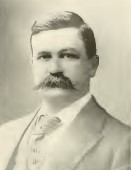 ROBERT JAMISON One of the best known and
ablest of the younger men of the district bench in
Minnesota is Judge Robert Jamison, of the Fourth
judicial District. He is of Irish descent, his father,
Alexander Jamison, and his mother, Mary (Roberts)
Jamison, having been born in the north of Ireland. They came of the
sturdy Presbyterian stock of that region, and while in
their teens emigrated to America. Alexander Jamison, who
became a mason and builder, located at Red Wing,
Minnesota, in 1857, and in the course of time became
well-to-do. ROBERT JAMISON One of the best known and
ablest of the younger men of the district bench in
Minnesota is Judge Robert Jamison, of the Fourth
judicial District. He is of Irish descent, his father,
Alexander Jamison, and his mother, Mary (Roberts)
Jamison, having been born in the north of Ireland. They came of the
sturdy Presbyterian stock of that region, and while in
their teens emigrated to America. Alexander Jamison, who
became a mason and builder, located at Red Wing,
Minnesota, in 1857, and in the course of time became
well-to-do.
Here his son Robert was born, September 4, 1858.
As a young man of nineteen that son was graduated from
the Red Wing high, school in 1877. Coming to Minneapolis
in the fall of that year he began a special course of
study in the state university, which lasted for three
years, and then, having previously made up his mind to
enter the profession of the law, he began his
preparatory work in the office of Judge John. M. Shaw, in
Minneapolis. In 1883 he was admitted to the bar and two
years later, in 1885 was appointed assistant county
attorney of Hennepin County. He distinguished himself
very early in this office by the skill which he
displayed in the prosecution of the Barrett brothers for
murder. These cases will be remembered as being among
the most sensational in the criminal history of Hennepin
County. In November 1888, Mr. Jamison, by vote of the
people, was advanced to first place in the county
attorney’s office. He served for 01-ie term as county
attorney and declined nomination for a second term. The
death of Judge Frederick Hooker, in 1893, created a
vacancy on the bench of the Fourth District, and Mr.
Jamison was appointed by Governor Knute Nelson in
September of that year, to fill it. In 1894 he was
elected to succeed himself for a term of six years,
commencing January 1, 1895. Although comparatively a
young man he has acquitted himself with great credit as
a judge and has developed high qualifications for the
judicial office. Mr. Jamison has always taken an active
interest in politics, and during the campaign of 1892
was chairman of the Republican state central committee.
In the field of practical politics the future was
opening up before him with considerable brilliancy when
he suddenly and quite unexpectedly to his many friends,
stepped aside in order to receive judicial honors. It is
not improbable, however, that he regards this retirement
as being only temporary. When elected to the bench for
the full term in 1894. he received the largest vote by
several thousand ever cast for a judicial candidate in
the Fourth District. Few men in the more recent
political life of Minnesota have had a larger or more
enthusiastic personal following, or have been more
worthy of it.
Mr. Jamison was a member of the Chi Psi
fraternity while in college. He is a Mason and an
Elk. August
16, 1883, he was married to Adaline L. Camp, of Minneapolis,
and three children have been born of the union. Glee,
Neil and Lou.
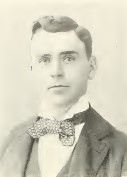 TRAFFORD
NEWTON JAYNE The success achieved in business and
professional life by the subject of this sketch, while
yet a young man, is a splendid example of what a man of
perseverance and industrious habits can make of himself
in the North Star State. Trafford Newton Jayne
was born near Lewiston, Winona County, Minnesota,
November 3, 1868. Havens Brewster Jayne,
his father, was by occupation a carpenter, in
straightened financial circumstances. His mother’s
maiden name was Nellie Victoria Pike. On his father’s
side Mr. Jayne is directly
descended from William Brewster, who came over in the
Mayflower. William Jayne came from England to Pawtucket,
Long Island, early in the Seventeenth century, and soon
after connected himself with the Brewster family by
marriage. The name was originally “De Jayne,” and an
officer of that name held high rank in the army of
William the Conqueror. During the reign of
Cromwell the De Jaynes were found with him, but after
the ascension of Charles H. to the throne, in order to
hide to some extent their identity, they dropped the
“De” from the family name, and that has since been
Jayne. TRAFFORD
NEWTON JAYNE The success achieved in business and
professional life by the subject of this sketch, while
yet a young man, is a splendid example of what a man of
perseverance and industrious habits can make of himself
in the North Star State. Trafford Newton Jayne
was born near Lewiston, Winona County, Minnesota,
November 3, 1868. Havens Brewster Jayne,
his father, was by occupation a carpenter, in
straightened financial circumstances. His mother’s
maiden name was Nellie Victoria Pike. On his father’s
side Mr. Jayne is directly
descended from William Brewster, who came over in the
Mayflower. William Jayne came from England to Pawtucket,
Long Island, early in the Seventeenth century, and soon
after connected himself with the Brewster family by
marriage. The name was originally “De Jayne,” and an
officer of that name held high rank in the army of
William the Conqueror. During the reign of
Cromwell the De Jaynes were found with him, but after
the ascension of Charles H. to the throne, in order to
hide to some extent their identity, they dropped the
“De” from the family name, and that has since been
Jayne.
Trafford Newton received his early
education in the district schools of Southern
Minnesota. He lived on the farm
near St. Charles until the age of three, when he was
taken to Mankato. In his fifth year he was again taken
back to St. Charles, returning two years later to
Winona. He attended the graded schools of Winona for
three years, when he was again taken back to the farm.
After two more years of farm life he again returned to
Winona, finishing the preparatory school work in the
freshman class in the high school proper when only
thirteen years of age. He then left school and studied
telegraphy and the railroad business at Lewiston,
Minnesota. In a little less than five months he was
given a position as telegraph operator and worked for
about eight months in that way. He was then appointed
cashier of the Chicago, Milwaukee & St. Paul
Railroad at Winona, when only fourteen years of age, at
a salary of sixty five dollars a month. He remained in
this position only a short time when he was offered a
better position as telegraph operator and ticket clerk
for the same road there. He retained this position for
about ten months, and was then appointed as the
assistant city ticket agent of the Chicago &
North-Western Railway at Winona. After being in this
position about eight months he was given the appointment
of cashier for the same road at Mankato.
Seeing the importance at this time
of further education he commenced preparation for a
college course, entering the University of Michigan in
the fall of 1886 and finishing in 1889, taking the four
years’ course in three years’ time.
While at college he took an active interest in
athletics and in 1889 took the university championship
at tennis, and shortly after, in the same year, defeated
the champion of Ohio in a match game. He was on the
university baseball team, was vice president of the
bicycle club, secretary and treasurer of the tennis
association, and also was secretary and treasurer of the
dramatic club, editor-in-chief of the Commencement
Annual, and a member of the Beta Theta Pi.
On
leaving college he returned to Minnesota and accepted a
position as chief clerk in the office of Williams and
Goodnow, at St. Paul, and in January 1890, was admitted
to the bar. Mr. Jayne remained in the same position for
a short time after admission to the bar, but commenced
active practice for himself on May 1, 1890. In November
of that year he went into partnership with C. B. Palmer,
under the firm name of Palmer and Jayne. This
partnership continued until the first of January, 1892,
when Mr. Jayne was offered the attorney-ship of the
Wilbur Mercantile Agency in Minneapolis and accepted it.
On April 1, of the same year, he entered into
partnership with R. G. Morrison, under the firm name of
Jayne & Morrison, which partnership continued until
1897 when the firm was dissolved. Mr. Jayne then formed
a partnership with A. L. Helliwell, under the name of
Jayne & Helliwell. They enjoy an extensive practice,
corporation and commercial law being their specialties.
In politics, Mr. Jayne is a Republican.
At college he was president of the University Republican
Club numbering six hundred members, and one of the vice
presidents of the Michigan State League of Republican
Clubs, at the age of twenty. He is at present a court
commissioner of Hennepin County. Mr. Jayne is a member
of the Commercial Club, and his church affiliations are
with the Methodist Episcopal Church, he is not
married.
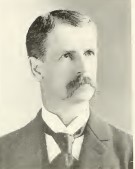 GEORGE WALTER JENKS A type of the successful
businessman, who succeeds by sheer pluck against all
obstacles in his path is George Walter Jenks, a
prominent banker and broker in the city of
Minneapolis.
Mr. Jenks was born April 10, 1852, in Warwick,
Rhode Island, and comes from good old Colonial stock on
both sides of the family. His paternal ancestor, Joseph
Jenks, born in England in 1602, and who died in Lynn,
Massachusetts, in 1683 was the first man to make cast
iron in America.
The iron founder’s son, Joseph, settled in
Pawtucket, Rhode Island, where his grandson, Jonathan
Jenks, married the grand-daughter of Roger Williams, who
had founded the state in 1636, or a few years only after
the arrival of the Mayflower. Many of the descendants of
this couple—among others sisters of the subject of
sketch—are still living at Pawtucket on the original
grant of land occupied by Jonathan Jenks and wife. His
mother, Phoebe Ann Aldred (Jenks), was the daughter of
Samuel and Elizabeth (Thomas) Eldred, both of old New
England families. GEORGE WALTER JENKS A type of the successful
businessman, who succeeds by sheer pluck against all
obstacles in his path is George Walter Jenks, a
prominent banker and broker in the city of
Minneapolis.
Mr. Jenks was born April 10, 1852, in Warwick,
Rhode Island, and comes from good old Colonial stock on
both sides of the family. His paternal ancestor, Joseph
Jenks, born in England in 1602, and who died in Lynn,
Massachusetts, in 1683 was the first man to make cast
iron in America.
The iron founder’s son, Joseph, settled in
Pawtucket, Rhode Island, where his grandson, Jonathan
Jenks, married the grand-daughter of Roger Williams, who
had founded the state in 1636, or a few years only after
the arrival of the Mayflower. Many of the descendants of
this couple—among others sisters of the subject of
sketch—are still living at Pawtucket on the original
grant of land occupied by Jonathan Jenks and wife. His
mother, Phoebe Ann Aldred (Jenks), was the daughter of
Samuel and Elizabeth (Thomas) Eldred, both of old New
England families.
George received but a common school education in
the public school of his native village. Though it was
the intention to give the lad a college education, the
sudden death of his father, when George was only fifteen
years old, called him from his studies to take temporary
charge of his father’s country store. He showed such an
adaptability for business that this arrangement became a
permanent one. He continued the business successfully
for several years, and then left for wider business
fields. After leaving his old home he secured a position
in a grocery store in Central Falls, Rhode Island. Here
he was advanced to the best position in the
establishment, but the work not being congenial, he
removed to Boston and secured a position in a publishing
house in that city. He was soon promoted to the
superintendency of the business in seven different
states, and assisted in building up several magazines.
In the fall of 1877, having contracted a severe cold on
his lungs, he came West in search of health, and,
visiting Minneapolis, decided to locate here. Finding no
position vacant to which he was adapted, he secured work
in a sawmill. The next year, having recovered his
health, he returned to his old business and more
congenial work of publishing. In January, 1880 he began
the publication of a magazine called the “Minnesota
Homestead,” which was afterwards changed to the
“Homestead Monthly.” for which he built up a large
subscription list. The work was too confining, however,
and Mr. Jenks decided to sell out.
He then changed to investment banking, which line
of business he has followed to the present time. In this
business Mr. Jenks has been very successful; but during
the panic of ‘93 a considerable portion of his fortune
was swept away, due, in a large measure, to his rigid
adherence to the honest purpose in his mind of standing
the loss himself rather than to knowingly unload
doubtful or rotten securities upon others. Mr. Jenks is
a loyal Minneapolitan, has always been identified with
the business interests of the city and the various
business organizations, and is a member of the Board of
Trade, Stock Exchange, Chamber of Commerce, Business
Men’s Union, Commercial Club, Northwestern Home Trade
Association, etc. He is a prohibitionist in politics as
well as in practice, as were his parents before him, and
has done many deeds of philanthropy in a quiet way for
the needy and unfortunate.
In January, 1874, he was married to Rosie B.
Arnold, an early schoolmate, who died a year later,
leaving one son, Walter Bertram. now a farmer near
Redwood Falls, Minnesota. Mr. Jenks was married again on
June 8, 1879, to Miss T. Addie Gail, a daughter of James
P. Gail, an early settler in Minnesota. Mrs. Jenks is an
accomplished artist and musician, and a writer of marked
ability, widely known through her contributions to
religious weeklies. Two children are the result of this union, George
Ernest and William Gail.
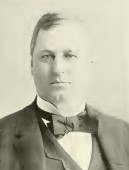 EDWARD
MORRILL JOHNSON was born in Fisherville, Merriniac
County, New Hampshire, November 24, 1850. In 1854 his
parents moved to St. Anthony, now a part of Minneapolis,
where they have since continuously resided. His father,
Luther G. Johnson is well known to pioneer settlers of
this section, having been engaged actively as a
manufacturer and merchant until recent years. He was a
member of the firm of Kimball, Johnson & Co., and of
L. G. Johnson & Co., two of the earliest mercantile
and manufacturing concerns of the city, the last named
firm having established the first furniture factory in
Minneapolis. Mr. Johnson’s
ancestors upon both his father’s and mother’s side were
among the earliest settlers of New England. Among the
former were a number of prominent founders of Andover,
Massachusetts, and Concord, New Hampshire, as well as
members of the Committee of Safety during the
Revolutionary War. EDWARD
MORRILL JOHNSON was born in Fisherville, Merriniac
County, New Hampshire, November 24, 1850. In 1854 his
parents moved to St. Anthony, now a part of Minneapolis,
where they have since continuously resided. His father,
Luther G. Johnson is well known to pioneer settlers of
this section, having been engaged actively as a
manufacturer and merchant until recent years. He was a
member of the firm of Kimball, Johnson & Co., and of
L. G. Johnson & Co., two of the earliest mercantile
and manufacturing concerns of the city, the last named
firm having established the first furniture factory in
Minneapolis. Mr. Johnson’s
ancestors upon both his father’s and mother’s side were
among the earliest settlers of New England. Among the
former were a number of prominent founders of Andover,
Massachusetts, and Concord, New Hampshire, as well as
members of the Committee of Safety during the
Revolutionary War.
He
first attended the pioneer school, which was kept in a
small frame building in St. Anthony, on what is now
University avenue, between Second and Third avenue S. E.
a building well remembered by the earliest settlers of
the city. Later he entered the first high school in the
city, which was organized at St. Anthony about 1863. The
school year 1866-67 was spent at the Pennsylvania
Military Academy, at Chester. He then attended for four
years the Minnesota State University, which had been
reopened in 1867, but left there before any class
graduated, and was for some time in his father’s
employment. In January, 1873, Mr. Johnson went to
Europe, where he remained nearly three years. While
there he visited nearly all of Central Europe, but spent
the most of his time at the universities of Heidelberg
and Berlin, where he studied law, including Roman and
international law, under Professors Windschied,
Bluntschli, Gneist and Bruns. He also attended courses
of lectures by Mommsen, Curtius, Grimm, Treitschke,
Wagner and other celebrated German professors.
At
the end of the year 1875 Mr. Johnson returned to
Minneapolis and early the following year entered the law
offices of Judge J. M. Shaw & A. L. Levi; later he
attended the law school of the Iowa State University at
Iowa City, where he graduated in 1877. Soon afterward he
opened a law office in Minneapolis in partnership with
Mr. E. C. Chatfield. Later this partnership was
dissolved and for four years he was alone. In January,
1882, Mr. C. B. Leonard entered into partnership with
Mr. Johnson. This firm, with the
addition of Mr. Alexander McCune, still continues. Mr.
Johnson has made a specialty of the law of corporations,
real estate and municipal bonds. He has been the
attorney and counsellor of the Farmers and Mechanics
Savings Bank of Minneapolis since 1883. For ten years he
was clerk and attorney for the Board of Education.
In
1883 he was elected to the city council from the Second
ward, and served in that body until 1890, when he
resigned, being at that time its president. It is
generally conceded, that, during Mr. Johnson’s term in
the city council, his views were most frequently the
controlling ones of that body. His career during that
time was marked with the same steadfastness and
fearlessness that has constituted him a leader among
men. One of the most important innovations of recent
years in municipal taxation originated with Mr. Johnson,
and by his unceasing efforts was brought to a successful
trial. It is what is known as the Permanent Improvement
Fund, by means of which a city is enabled to improve and
beautify its streets while the tax upon property owners
for payment of the expense is divided into five equal
annual assessments. Since the successful operation of
this measure in Minneapolis the principle has been
incorporated into the laws of some of our surrounding
states. By Mr. Johnson’s tact the
system of street railway transfers was brought about.
That Mr. Lowry realized this fact and gave him the
credit of forcing the measure upon his company is
manifest in a reminder Mr. Lowry presented Mr. Johnson
in the form of a transfer check printed upon satin and
handsomely framed in mahogany. A few years ago a
suspension bridge stood on the site of the present Steel
Arch Bridge. The roadway was narrow and was fast
becoming inadequate to the demands made upon it and the
strain of projected electric cars would have proved more
than the bridge could sustain. With remarkable firmness
Mr. Johnson undertook to replace the suspension bridge
with one of steel. The cause he so championed created
great public opposition, but he fought it through to a
successful termination, and today no one of Mr.
Johnson’s efforts is more appreciated by the public than
that of securing the fine steel arch bridge in place of
the old suspension one.
One
of Mr. Johnson’s most valuable services to the public
was in connection with the Minneapolis Public Library.
Through his efforts the plan finally adopted sprang into
vital action. As chairman of the council committee which
had that matter under consideration, as well as chairman
of the council committee on legislation, he drafted the
Library Board charter and urged it through the
legislature. Poole, the recognized
authority on library matters, said it was one of the
best laws for the government of libraries he had ever
examined. After securing the passage of the library act
he was made one of the directors of the Library Board,
and has been and is now one of its most efficient
members. As a director of the Society of Fine Arts Mr.
Johnson has given it enthusiastic support.
In
1887 he was appointed one of the commissioners having in
charge the erection of the new courthouse and city hall,
and was for a number of years its vice-president,
chairman of its financial committee, a member of its
building committee, and for the past two years its
president. In all these positions
of responsibility Mr. Johnson has given his
time and labor without one thought of pecuniary reward.
Through his efforts the Northwestern Casket Company and
the Minneapolis Office and School Furnishing Company
were established; and of both concerns he has long been
president. In politics Mr.
Johnson has always been a Republican and actively
interested in the success of his party. In 1892 he was
chairman of the city committee, and by virtue of such
office was a member of the Republican Campaign Committee
of that year. In 1894 he was appointed chairman of the
County Committee, which made him chairman of the
Republican Campaign Committee. In 1896 he was appointed
member at large and secretary of the State Central
Committee. In 1890 Mr. Johnson married Effie S.
Richards, daughter of Mr. W. O.
Richards, of Waterloo, Iowa. He has a pleasant
home on Fourth street and Tenth avenue SE., in the
immediate vicinity of where his parents located in 1854,
and still reside.
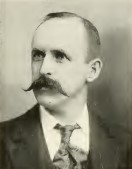 GUSTAVUS JOHNSON is a teacher of
music and composer in Minneapolis. His father, Peter
Johanson (Johan being the Swedish for John), was a
merchant in Stockholm from 1860 until his death in 1887.
Previous to 1860 he was for some twenty-five years a
successful businessman in England, whither he went at
the age of seventeen from Sweden, the country of his
birth. In England he married Henrietta Hole, daughter of
the late Admiral Lewis Hole, of the English Navy.
Admiral Hole, grandfather of the subject of this sketch,
was for seventy-five years in her majesty’s naval
service and was at the time of his death, his age being
ninety-two, the oldest officer in the English navy. He
had fought in many battles, the most notable being that
of Trafalgar, where he was lieutenant under Lord Nelson
and where he fought on the same ship on which Nelson was
killed. GUSTAVUS JOHNSON is a teacher of
music and composer in Minneapolis. His father, Peter
Johanson (Johan being the Swedish for John), was a
merchant in Stockholm from 1860 until his death in 1887.
Previous to 1860 he was for some twenty-five years a
successful businessman in England, whither he went at
the age of seventeen from Sweden, the country of his
birth. In England he married Henrietta Hole, daughter of
the late Admiral Lewis Hole, of the English Navy.
Admiral Hole, grandfather of the subject of this sketch,
was for seventy-five years in her majesty’s naval
service and was at the time of his death, his age being
ninety-two, the oldest officer in the English navy. He
had fought in many battles, the most notable being that
of Trafalgar, where he was lieutenant under Lord Nelson
and where he fought on the same ship on which Nelson was
killed.
Gustavus Johnson, the subject of this sketch, was
born at Hull, England, November 2, 1856. He was four
years of age when his father returned with his family to
Sweden and located at Stockholm. Gustavus attended the
regular high school there and the Royal Conservatory of
Music. His principal teachers were: In piano, Linstrom,
Mankell and Nordquist; in theory, Mankell, and Winge and
in singing, Hackanson. Mr. Johnson
continued the study of music until 1875. He was also
given a business training in a commercial college in
Stockholm, and at the age of nineteen, in 1875, came to
Minneapolis, where he has been engaged in teaching the
piano, with short intervals of residence in other
places.
For three years his residence was in Wisconsin,
and at various times he has traveled and played in
concerts in every city of any consequence in the
Northwest.
He has achieved especial distinction as a
performer and for his general theoretical knowledge of
his art many of his pupils have become finished artists
and others successful teachers. He has also attained to
some eminence and popularity as a composer, many of his
compositions having been published—among them a piano
concerto, with full orchestra accompaniment; a trio for
piano, violin and cello; a violin sonata; numerous
smaller works for the voice; anthems, quartets, songs,
etc., and, besides, several piano pieces, some of which
are used in their instruction by the best teachers all
over the country.
Prof. Johnson is a member of Hennepin Lodge, A.
F. and A. M. He was married in 1882 to Caroline Francis
Winslow, of South Royalton, Vermont. Mrs. Johnson is of
an old New England family and a direct descendant of
Edward Winslow, who came over in the Mayflower, and one
of the early Colonial governors of Massachusetts. Mr. and Mrs. Johnson
have one daughter, Laura Louise, born in 1890.
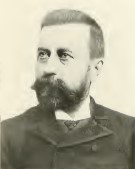 WILLIAM E. JOHNSON is a member of the
Minnesota senate, elected from the Twenty-ninth
District, which comprises a part of the city of
Minneapolis, he is a son of the late James Johnson, and
was born at Palestine, Columbiana County, Ohio, February
8, 1850. His ancestry were among the early settlers of
New Jersey, Pennsylvania and Ohio. They settled near
Cleveland, Ohio, in the year 1810, and took part in the
Revolutionary War and in the Indian wars of the early
history of Ohio. WILLIAM E. JOHNSON is a member of the
Minnesota senate, elected from the Twenty-ninth
District, which comprises a part of the city of
Minneapolis, he is a son of the late James Johnson, and
was born at Palestine, Columbiana County, Ohio, February
8, 1850. His ancestry were among the early settlers of
New Jersey, Pennsylvania and Ohio. They settled near
Cleveland, Ohio, in the year 1810, and took part in the
Revolutionary War and in the Indian wars of the early
history of Ohio.
Senator Johnson was educated in the common
schools, and began business in the railway service in
which he was engaged until 1891. He went to South Dakota
in 1881 as assistant superintendent of the Dakota
division of the Chicago & Northwestern Railroad, and
was the principal mover in the organization and
settlement of Hand County having it surveyed by the
United States government and opened for settlement. This
was done, too, in a time which required nerve,
enterprise and perseverance to secure an economical and
business-like management of public affairs, there being
so many men ready in those days to take advantage in the
organization of new counties to set up schemes for their
private advantage, but both Hand and Beadle Counties owe
to Mr. Johnson’s prudence and careful management the
fact that they were unusually free from the burdens
which were laid upon many of the new Western
communities. When he left that country some ten years
later the people gave him a handsome testimonial in
recognition of his public services.
He came to Minneapolis in 1891 and accepted the
presidency of the Guaranty Savings and Loan Association
in Minneapolis.
He has taken an active interest in building up
this line of financial investment, and has a national
reputation as a promoter of building and loan
associations. He is a member of the executive committee
of the Interstate League of National Building and Loan
Associations of the United States. This committee
consists of seven members, and is organized on lines
similar to that of the American Bankers’ Association.
Mr. Johnson never took a very active part in politics
until 1894, when he was selected by his district as a
candidate for the state senate. He was elected as a
member of that body, and in the session of 1895 received
his first introduction to public affairs. He is a
Republican in his affiliations, and occupied an
important position in the delegation which represented
his city in the senate. As a member of that body he took
an active interest in labor legislation ; was a member
of the committee on labor, and exerted an important
influence in shaping the legislation of the session. Mr.
Johnson is thoroughly in sympathy with the labor
classes, and a firm believer in their improvement and
betterment through education, believing that a better
understanding of the relations between labor and capital
by both employer and employee will greatly promote a
more harmonious relation and more judicious co-operation
between them.
Mr. Johnson is an attendant on the services of
the Episcopal church, and enjoys the confidence and
esteem of a large circle of acquaintances, who hold him
in high regard for his personal qualities and devotion
to public interest. He takes an
active interest in municipal questions, and is a
diligent student of the problems of municipal
government. He is a firm believer in the mayoralty
system of municipal government, believing that that
office should have large powers and a wide range of
authority. Mr. Johnson was married at Lima, Indiana, to
Harriet I. McNabb June 2, 1869, and has five
children.
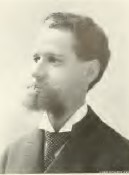 HARRY WILD
JONES is an Architect in Minneapolis. Mr. Jones is the
son of Rev. Howard M. Jones, at present retired and
living at Cedar Falls, Iowa. Rev. Howard M. Jones was
the son of the late Dr. John Taylor Jones, who was for
many years a missionary at Bangkok, Siam, where Howard
M. was born, and from which place he was sent to this
country when four years old to be educated. He graduated
from Brown University in the class of 1853, and from the
Newton Theological Seminary in 1857, after which he
traveled in Europe and Palestine for several months. He
then entered the ministry and served parishes in New
York, New England, Iowa and Michigan. His wife, the
mother of the subject of this sketch, was Mary White,
the eldest daughter of the late Rev. Dr. Samuel Francis
Smith, the venerated author of the national hymn
“America.” and many other well known sacred hymns. Dr.
Smith was also a linguist of some note. HARRY WILD
JONES is an Architect in Minneapolis. Mr. Jones is the
son of Rev. Howard M. Jones, at present retired and
living at Cedar Falls, Iowa. Rev. Howard M. Jones was
the son of the late Dr. John Taylor Jones, who was for
many years a missionary at Bangkok, Siam, where Howard
M. was born, and from which place he was sent to this
country when four years old to be educated. He graduated
from Brown University in the class of 1853, and from the
Newton Theological Seminary in 1857, after which he
traveled in Europe and Palestine for several months. He
then entered the ministry and served parishes in New
York, New England, Iowa and Michigan. His wife, the
mother of the subject of this sketch, was Mary White,
the eldest daughter of the late Rev. Dr. Samuel Francis
Smith, the venerated author of the national hymn
“America.” and many other well known sacred hymns. Dr.
Smith was also a linguist of some note.
Harry W., the subject of this
sketch, was born in Michigan in 1859, and educated at
the University grammar school at Providence, R. I., and
Brown University. Leaving there in 1880 he spent two
years at the Massachusetts Institute of Technology in
Boston in the study of architecture. At the completion
of his course in the institute he entered the office of
the late H. H. Richardson as a student and draughtsman.
Here he remained for a year, and he regards the time
spent under the tutelage of this man, one of the
greatest of modern architects, as of the highest value
to him, and feels that the influence attending the
association with so great a master had much to do with
moulding his tastes in his chosen art and
profession.
In
1883 he married Miss Bertha J.
Tucker, of Boston, and in July of the same year
came to Minneapolis to establish himself in his
profession. The first year in Minneapolis was spent in
the office of Plant & Whitney, architects.
He then went to Europe, where he spent several
months in travel and study, returning in 1885 and
opening an office on his own account as an Architect.
During the past eleven years in which he has practiced
his profession in Minneapolis he has made plans for
several hundred buildings of both a public and a private
nature, and has counted among his clients the Bank of
Commerce, the University of Minnesota, the Minnesota
Land and Investment Company, of Minneapolis; George A.
Pillsbury, H. E. Ladd and S. G. Cook, of Minneapolis,
and the Minneapolis Street Railway Company. His work has
not been confined to Minneapolis, however, but may be
found in New York, New Hampshire, Massachusetts, Ohio,
Illinois, Wisconsin, Iowa, Missouri, Kansas, the Dakotas
and the District of Columbia.
For
two years he filled the position of professor of
architecture in the University of Minnesota, at the same
time. carrying on the practice of his profession. In
1892 he was elected by the Republicans to membership on
the Park Board of Minneapolis for a period of six years.
He is a director of the Board of Trade, and also of the
Young Men’s Christian Association, and holds membership
in the Commercial Club. He is also President of the
Minnesota Chapter of the American Institute of
Architects. In a recent competition for plans for the
new Minnesota state capitol, Mr. Jones was awarded the
fifth prize of $500, among forty-two competing
architects. Mr. Jones’ religious affiliations are with the
Baptist Society and includes membership in the Calvary
Church of Minneapolis. He has three children living.
Harry Malcolm, Mary White and Arthur
Leo.
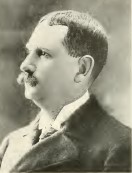 FRANK MELVILLE JOYCE Colonel Frank M. Joyce
was born at Covington, Indiana, March 18, 1862. His
father is Bishop Isaac W. Joyce, one of the most
distinguished of the bishops of the Methodist Episcopal
Church, and now resident in Minneapolis. Bishop Joyce,
when a minister in the denomination, went to Cincinnati
from Indiana and became very popular as pastor of St.
Paul and Trinity churches in that city. He was
subsequently chosen bishop by the largest vote ever cast
for that office. F. M. Joyce’s mother was Miss Carrie
Bosserman, of an old Pennsylvania Dutch family. Bishop
Joyce is of Irish descent. FRANK MELVILLE JOYCE Colonel Frank M. Joyce
was born at Covington, Indiana, March 18, 1862. His
father is Bishop Isaac W. Joyce, one of the most
distinguished of the bishops of the Methodist Episcopal
Church, and now resident in Minneapolis. Bishop Joyce,
when a minister in the denomination, went to Cincinnati
from Indiana and became very popular as pastor of St.
Paul and Trinity churches in that city. He was
subsequently chosen bishop by the largest vote ever cast
for that office. F. M. Joyce’s mother was Miss Carrie
Bosserman, of an old Pennsylvania Dutch family. Bishop
Joyce is of Irish descent.
Colonel Joyce attended the public schools of
Lafayette, Indiana, and afterwards graduated from
Indiana Asbury University, now De Pauw University. He
took the gold medal of his class for mathematics. During
the last year of his college career he was major of the
Cadet Battalion, and captain of the famous Asbury
Cadets, who won the first national artillery prize at
Indianapolis in 1882, over many competing batteries from
all over the United States. Early in his college days he
was initiated into the bonds of Beta Theta Pi, a
prominent Greek letter fraternity, with which he has
ever since been highly connected. After graduation
he went to Cincinnati, Ohio, and became paying teller of
the Queen City National Bank.
Five years later he resigned to accept the
general agency of the Provident Life and Trust Company,
at Cincinnati. He was associated with that company until
1890 when he entered the services of the Mutual Benefit
Life Insurance Company, of Newark, New Jersey, as
district agent at Cincinnati. Having established himself
as a successful and entirely reliable insurance man,
Colonel Joyce, after a few years with the Mutual
Benefit, was transferred to Minneapolis as state agent
of that company for Minnesota and the Dakotas. Since
coming to Minneapolis he has made a large circle of
friends both in the social and business communities of
the city. He is a member of the Hennepin Avenue
Methodist church, and of the leading business
organizations of the city. He is also a member of the
Knights of Pythias, Blue Lodge, Chapter, Knights
Templar, and is a thirty-second degree Scottish Rite
Mason.
He is also an honorary member of the Army and
Navy Military Service Institute. Colonel Joyce’s title
is by no means an honorary one only. He was a
commissioned officer of the Indiana Legion, and later
commander of the Second Battery Ohio National Guard. It
was while in this position, at the time of the famous
Court House riots in Cincinnati in 1884, that he
rendered such service as to receive the special
commendation of Gov. Hoadly. In 1889
Colonel Joyce organized the Avon Rifles from among the
best young men of Avondale, a suburb of Cincinnati,
where he resided.
He also had the honor of being a member of the
personal staff of Governor McKinley, of Ohio, which
position he held until he left the state. While in
Cincinnati, Colonel Joyce was quite prominently
connected with the musical affairs of the city, and was
president of the Orpheus Club, the leading male chorus
in a city famed for its musical culture, from the time
of its organization until his removal to this city.
On March 20, 1883, he was married to Miss Jessie
F. Birch, daughter of the late Honorable Jesse Birch, a
prominent lawyer of Bloomington, Illinois. They have four
children, Arthur Reamy, Carolyn, Wilbur Birch, and
Helen.
The information
on Trails to the Past © Copyright
may be used in personal family history research, with
source citation. The pages in entirety may not be
duplicated for publication in any fashion without the
permission of the owner. Commercial use of any material
on this site is not permitted. Please respect the
wishes of those who have contributed their time and
efforts to make this free site possible.~Thank
you! | | | |



